By Jeffrey A. Rendall, Photos by Jeff Janas
CARLSBAD, CA – “The playing surfaces had just degraded beyond repair. You had to start over,” said golf architect Damian Pascuzzo in describing the task he and design partner (and Tour pro) Steve Pate faced in redoing the famous Champions Course at the Omni La Costa Resort & Spa in the beautiful seaside community of Carlsbad, California.
(Ed note: Pascuzzo & Pate collaborated with architect Jeff Brauer at La Costa.)
Like many layouts built decades ago, the Champions Course (previously known as the North Course) was a shadow of its former self, having degraded to the point where course conditions could not stand up to La Costa’s history and typical billing as a top notch golf destination.
Together with the Legends Course, La Costa has hosted 37 PGA events over the years, probably most well known as the site of the Accenture World Match Play for a number of years around the turn of the century. The Match Play left for Tucson in 2008.
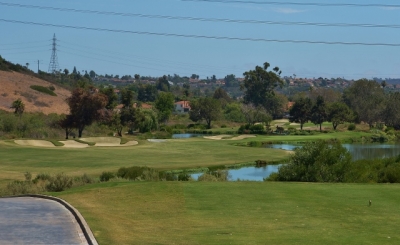 |
| You will not need driver on the picturesque par four 11th hole, but accuracy is a must. |
Pascuzzo and Pate (and Brauer) left many of the original Dick Wilson features in place on the Champions Course, but also gave it a new flair. As Pascuzzo explains below, the course looks and plays some different than the old one – but that’s a good thing. Moving on does have its benefits.
Here’s a look at the “new” Champions Course, in the words of Damian Pascuzzo:
GolfTheUnitedStates.com: When approaching the redo of a classic design like La Costa North, do you feel extra pressure to preserve as much of the original design as possible?
Pascuzzo: Not really. You want to define the essential elements of the design and preserve those as best you can.
But you also have to balance that desire with the way the game has changed in recent times. You now have the club and ball technology to contend with and maintenance practices are way different than before. Environmental conditions are also far different than when the course was originally built.
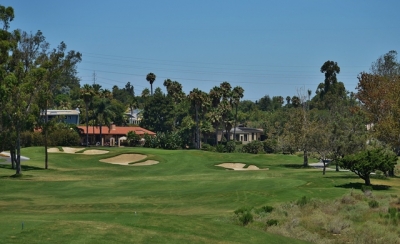 |
| Right from the start, you will notice the native areas at the Champions Course. Here, the 1st tee. |
We felt that, on the Champions Course especially, there were a number of the strong Dick Wilson elements still left before we started. You know -- the perched greens, the strong bunkering, the angled approaches… So we tried to retain all of those.
But beyond that, we were pretty much able to take some liberties. And there were definitely some flaws out there that we fixed.
GolfTheUnitedStates.com: What needed to be changed on the course that led to a complete redo?
Pascuzzo: Well, the infrastructure of the course was really compromised.
I went back and calculated it. Out of the total construction budget, I think it was like 82% of the money went to things the golfers will never see. Things like irrigation, drainage, sand capping, greens mix...
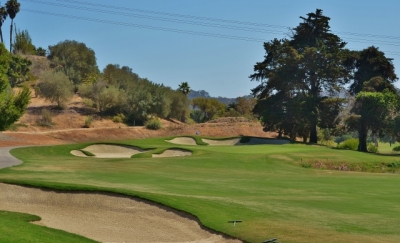 |
| Stay out of the bunkers at the tight dogleg right par four 13th hole. |
The playing surfaces had just degraded beyond repair. You had to start over. And that’s what necessitated the full redo. The irrigation system was antiquated, there was virtually no drainage. The fairways, because they sit in the bottom of this enormous watershed -- the fairways were horrible soils… Everything you could want to try and eradicate.
GolfTheUnitedStates.com: Was there anything about the site that was difficult to overcome?
Pascuzzo: Not compared to other projects I’ve worked on. We built golf courses in some ridiculous places in the 90’s.
Oddly enough, I think Jeff Brauer said it best: “the great thing about La Costa is that you can grow anything there. The bad thing about La Costa is that you can grow anything there.”
I think the grassing issue was probably our biggest debate – I wouldn’t even say it was a challenge. That’s because La Costa -- for most of the year it’s cool, but you get a little bit of hot temperature in the summer for maybe 8-10 weeks. So it’s not a great cool season grass climate and it’s not a great warm season grass climate either.
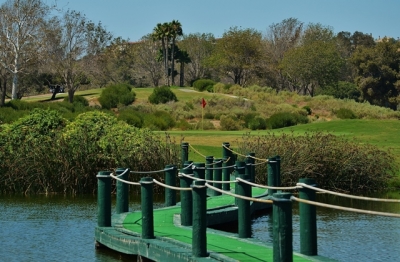 |
| The Champions Course is still a very nice walk. |
Plus, you’ve got horrible water quality and poor soil conditions to deal with there. Those factors lead you towards warm season grasses but yet, the temperatures really aren’t hot enough over a long period of time to get great Bermuda grass for a big part of the season.
We saw it as a tweener and that was probably the biggest challenge, to try and figure out how we wanted to grass the place.
GolfTheUnitedStates.com: So what did you end up with?
Pascuzzo: We went with A4 bentgrass on the greens – that was never an issue. We put 419 Bermuda grass on the tees, fairways and primary roughs. The outside roughs are an amalgam of everything – cool season, warm season, native grasses… whatever the wind blows in. It’s a real Heinz 57 out in the secondary roughs and the natives.
GolfTheUnitedStates.com: Was there any concern that toughening up the layout (taking out a lot of maintained turf) would make it too difficult for resort players?
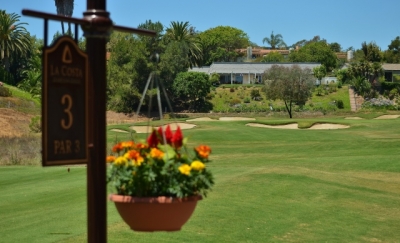 |
| Test the wind on the par three 3rd hole. |
Pascuzzo: It’s interesting -- a lot of people say we’d toughened it up.
But we had the state amateur out there last August – and the Legends Course actually played tougher than the Champions. During Medal play, the Legends Course was like four-tenths of a stroke harder those first two days.
I think what happens is, visually, it’s tougher … it’s intimidating visually. After you play it a few times and you understand the strategy a little bit better -- and the areas to avoid -- it really softens.
But the first time out, that visual intimidation is pretty strong.
Believe it or not, we increased the number of tee spaces for players on the Champions Course – so there’re five sets of tees out there now. Before I think they only had three. We greatly varied the yardages that people can play from too. The shortest is 4200 and you can play back to just over 7000 yards that was there before.
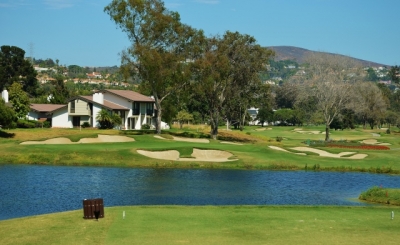 |
| The beautiful par three 16th is one you will remember from seeing on TV. |
We’ve given people a couple of options to play it between five and six thousand and a couple options to play it between six and seven thousand yards. Those options didn’t exist before.
And the “toughening up” aspect happens on every project. Because La Costa has a members’ component – the members are used to playing it from a certain tee marker. Now the course has changed and they need to rethink about where they tee it up from to match their skill set. That process takes a little while.
The steep-faced bunkers that are there, that’s right out of Dick Wilson’s playbook. The long noses and stuff – that’s what he had. We actually softened a few of them. But the total square footage of bunkers is within five or ten percent of what was there before. The greens are also a touch larger.
People probably think it’s tougher now because of the native areas. We took a little over thirty acres and converted it to non-irrigated areas – whether it’s mulch or native plant. That is absolutely a big difference. Whereas before members or guests could blow it forty yards offline and still find it -- they can’t do that now.
GolfTheUnitedStates.com: We experienced that first-hand.
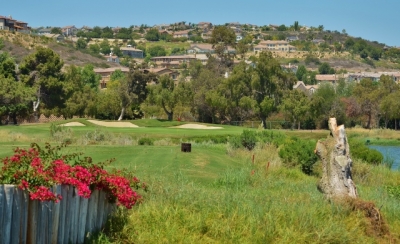 |
| Water intimidates on the par three 8th hole, but it should not come into play unless you chunk it badly. |
Pascuzzo: I’ve done the same thing. I’m a victim of my own efforts!
But I think what’s interesting in having played the Champions Course a number of times now, the attitude that you need to go onto that golf course with, is, ‘I don’t need to hit it long, I need to stay out of the bunkers. I need to keep it on the grass somewhere.’
You’ve got to think that sometimes hitting a five-iron instead of a hybrid or three-wood instead of driver is a good choice, because managing the course is now about control and positioning more so than length. Again, that’s something some golfers are going to pick up on and some won’t. Some people think golf is hitting fourteen drivers during a round… hit it as far as I can every single time.
GolfTheUnitedStates.com: Right. In terms of the layout, was the primary goal to build a course that would once again attract a PGA Tour event?
Pascuzzo: Not from the previous owners (who were responsible for the redo).
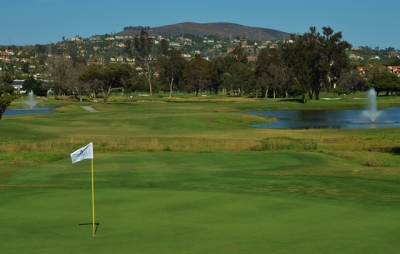 |
| Looking from behind of the flag at the long and difficult par five 18th hole. |
But that whole philosophy could be different with the Omni folks. They may have a bigger appetite for that type of thing.
Hosting the state amateur the first year is a nice step in that direction.
GolfTheUnitedStates.com: The Champions Course is the one that used to host the Match Play, is that right?
Pascuzzo: No. Part of the Champions did. They played a composite layout.
The quick history of it – the original eighteen at La Costa consisted of what I call the “center” portion. On the Champions Course, you play numbers one, two and three and then you cross the street, right? Then you go through the tunnel.
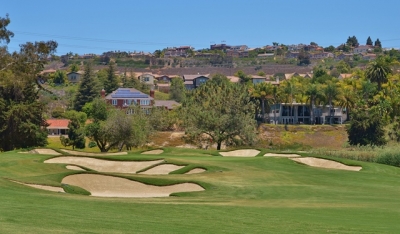 |
| Nearly all of the holes on the Champions Course are accessible in front, but also well bunkered. Here, the green of the par five 2nd hole. |
On the original eighteen, you never went through the tunnel. The original eighteen went holes one, two and three, then turned around and went thirteen, fourteen, fifteen, sixteen, seventeen and eighteen.
And then it played what is now the back nine of the Legends Course.
That was the original course in ’65. Then in the 70’s, I think they added nine to the Legends Course to create 27 holes. Then a couple years later they went to the other side of that tunnel and added the nine out there to create 36. They took the original 18 and split it.
When the Accenture was there, they played that composite that I described to you. They played the original eighteen holes.
GolfTheUnitedStates.com: That explains why some of the holes looked very familiar and some didn’t.
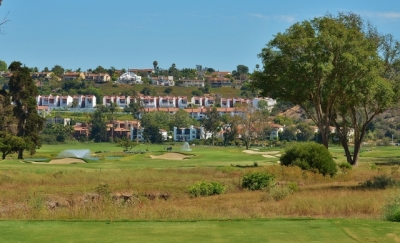 |
| At 340 yards from the back tee, long hitters can try to get close to the green on the par four 15th hole. |
Pascuzzo: Holding high profile professional tournaments was also one of the problems operationally. When we were first hired-on, we asked them about their plans in bringing events back and making that composite tournament course available. They said no, because a tournament requires nine holes off of each eighteen now.
And it screws up operations. Some of their guests were saying “We came to La Costa because we wanted to play the tournament course and we can’t do it.”
GolfTheUnitedStates.com: Anything else notable about the La Costa Champions project that stands out?
Pascuzzo: For me, it was a wonderful experience because I got to collaborate with a good friend of mine, Jeff Brauer. I’ve been in the business 30 years and I’ve never really collaborated with another architect on a project.
Jeff and I have been friends for a long time and we talked about it and this opportunity finally presented itself. We were able to ham and egg it – I learned a lot from him, hopefully he learned a few things from me.
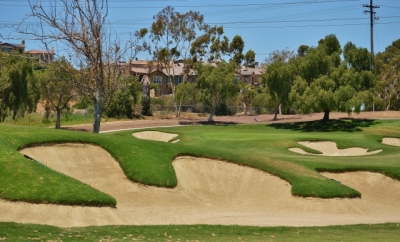 |
| If you miss off the tee, expect to find a fairway bunker waiting. Here, the par four 4th hole. |
We’re still friends -- so that tells you something!
You don’t see a lot of collaborations these days. Back in the 20’s and 30’s it wasn’t uncommon at all for guys to collaborate. Or, a competing architect would visit a project for a week and offer some insight.
Certainly Pine Valley has that kind of history and out here on the west coast, Robert Hunter used to consult with MacKenzie and they ended up being partners. But you don’t see a lot of it in modern times. It was a fun experience for me and for Pate also. He learned a lot from Jeff.
GolfTheUnitedStates.com: Anything unique to this particular project?
Pascuzzo: The other thing we’re really happy about was being able to add the “express” tees.
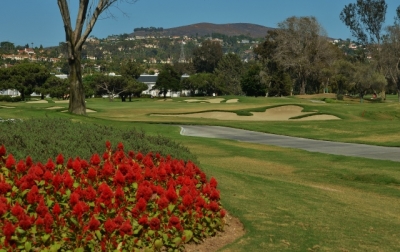 |
| Even during the summer, there is no shortage of flowering color at La Costa. |
Those tees are at 4200 yards. People are slowly starting to understand how to use those and the resort is showing support a little bit more.
The concept of the express tees is in sync with the things the entire golf industry is trying to do today in terms of faster play, more welcoming to beginners, alternative types of golf…
Pate and I went out and played fifteen holes from the express tees in about an hour and 20 minutes.
When we finished those fifteen holes, I said, “What did you think?” He said “It was really fun. The thing is, no matter what you hit off the tee, you still have to chip and putt.” And I thought, oh man, now there’s a guy who plays the game for a living. Because he clearly identified what is the most critical part of the game, which is chipping and putting.
We’ve tried to explain to people that, if you’re short on time, play from the express tees. It’s fun, first of all, because they all kind of become monster par threes or driveable par fours. But you’re still chipping and putting on every hole, so you’re still working on a critical part of your game.
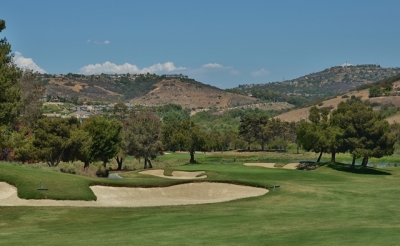 |
| Elevation changes add character to the Champions Course. Here, the par four 7th hole. |
And you can still feel like you played golf.
GolfTheUnitedStates.com: It’s a great idea.
Pascuzzo: I’ve talked to some other architects and they’re doing similar things.
I really think architects are five to ten years out in front of the rest of golf industry.
For example, way back in the 80’s, when I first joined ASGCA, we were talking about “brown is beautiful” back then. This whole concept of going from wall to wall, perfectly manicured turf to something less. We were clearly ten to fifteen years ahead of everybody else on it.
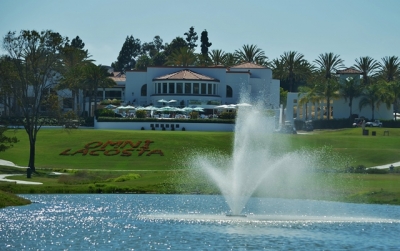 |
| The beautiful Omni La Costa clubhouse. |
For a long time now, architects have been talking about “alternate” forms of golf. There’s a guy named Bill Amick down in Florida who’s been proposing using a larger cup. Now the guy from TaylorMade gets all the news about the 18-inch cup – but Bill Amick suggested it about 30 years ago.
Gil Hanse did the ‘horse course,’ which is kind of this little short thing. We did the challenge courses. Bandon’s got their little 13 or 14 hole deal…
I’m not patting our backs, I just think the ideas we’re seeing become somewhat mainstream today had their origins ten or fifteen years ago.
___________________________________________________________________________
In that sense, the Champions Course is both a glimpse of the past and possibly the future. As is true with all current or former PGA Tour venues, it’s always fun to play where the pros have teed it up.
There’s much more to a stay at the resort and spa. Consult the website for details.
We thoroughly enjoyed our brief visit to La Costa – a place that certainly proves that moving on also means getting better.
Details:
Omni La Costa Resort & Spa
2100 Costa Del Mar Road
Carlsbad, CA 92009
Phone: (800) 854-5000
Concierge: (760) 929-6378
Website: www.LaCosta.com
Tee Times: http://www.omnihotels.com/hotels/san-diego-la-costa/golf/book-tee-time
Champions Course: Established: 1965
Architects:
Dick Wilson (1965)
Joe Lee (1973, 1984)
Damian Pascuzzo, Steve Pate & Jeff Brauer (2011)
Tees/Yardage/Slope/Rating
Black 7,172 75.1 / 140
Blue 6,747 73.0 / 135
White 6,299 71.0 / 129
Gold 5,881 75.5 / 139
Green 4,356 M:61.7 / 104 W:66.3 / 120
Red 5,366 72.2 / 133
Rates: Check the website for current rates and specials.
| Related Links | Comments on this article? | |
|
Maryland National Golf Club Hollow Creek Golf Club Rocky Gap Resort PB Dye Golf Club in Ijamsville Whiskey Creek Golf Club |
E-mail Jeff Rendall, Editor: jrendall@golftheunitedstates.com |











